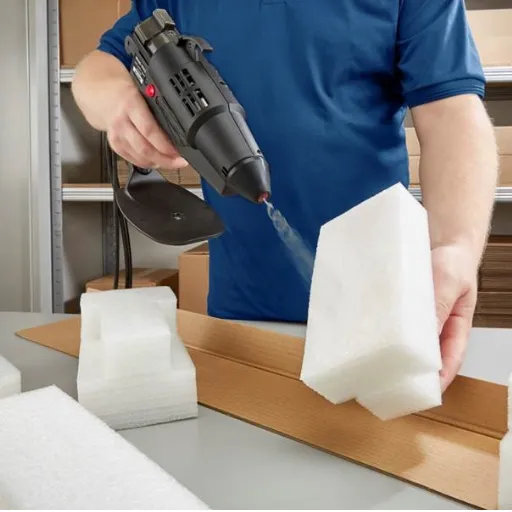Both the gluing process and XPS-/Styrofoam materials are hard to handle, especially when one is not sure what adhesives are safe and work well. A hot glue gun is the usual tool for many crafters and DIYers-but is it suitable for our fragile foams? This article takes a look at hot gluing for XPS and styrofoam, outlining the usefulness and the drawbacks, in terms of temperature-based reactions, as well as alternatives in adhesives. Whether for a school project, crafting, or home improvement, this guide imparts the knowledge necessary to take an informed stand and avoid simple errors.
Understanding Hot Glue and Its Applications
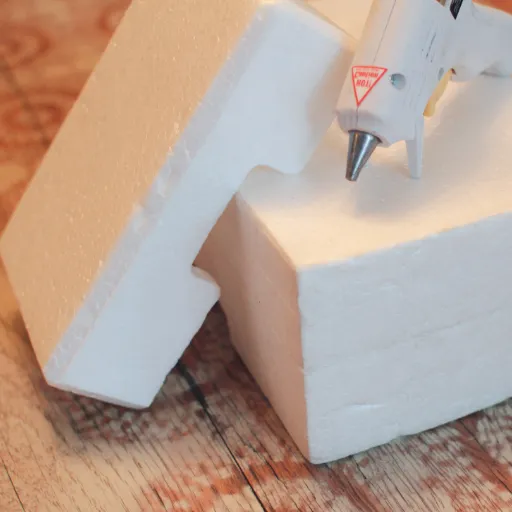
What Is Hot Glue?
Hot glue refers to an adhesive that finds applications in crafting, DIY projects, and repairs. It is composed of a thermoplastic material, which melts upon heating and solidifies upon cooling. This forms a strong bond with the surfaces. Hot glue is applied through a glue gun, which melts the glue sticks at the required temperatures for application.
The greatest advantage of hot glue lies in its drying and bonding time. It sets in a matter of seconds after application, which allows for working in speed-demanding projects that require fast assembly. It can bond materials such as paper, fabric, wood, and plastics, instead of being restricted to a particular application. But this heat can sometimes be a drawback for temperature-sensitive surfaces like certain foams.
How Does a Hot Glue Gun Work?
The operation of a hot glue gun involves heating solid glue sticks to their melting point, thus transforming the adhesive into molten. After the glue stick has been loaded into the gun, the heating element inside would heat up and melt it. Then the molten glue is forced through the nozzle by activity exerted by the user, usually pressing a trigger, so that it can be applied onto the surfaces being bonded.
As the glue cools down and hardens, it strongly bonds the surfaces together. This glue works well on wood, fabric, plastics, and metal, allowing for a very wide array of applications. But since the glue cools within seconds and quick hardens, the ingredients need to be applied, and materials have to be positioned quickly for the best results before the glue solidifies.
Types of Glue Guns:
- High-temperature glue guns: Suited for materials which can resist greater heat and form strong bonds
- Low-temperature glue guns: Good for fragile or heat-sensitive materials to avoid damage
Benefits of Using Hot Glue
⚡ Fast Drying Time
Enables projects to be completed without much delay. Perfect for immediate binding, quick fixes, crafts assembly, or temporary holding.
🔧 Great Adaptability
Works with fabric, plastic, metal, wood, and ceramics. Suitable for various scenarios from crafts to industrial applications.
💰 Cost-Effective
Simple design, cheap glue sticks, user-friendly for beginners. Reliable and economical choice for various projects.
Styrofoam and Its Properties
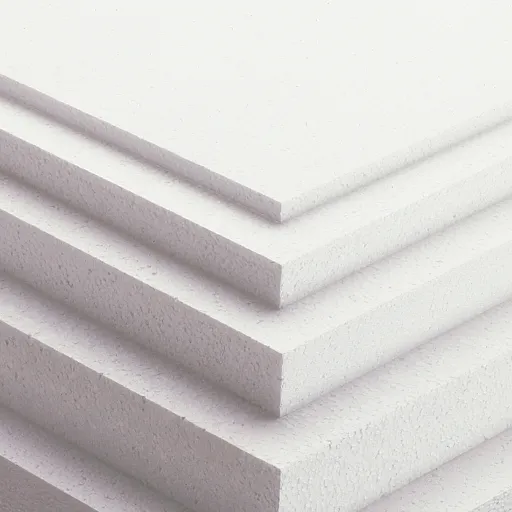
What Is Styrofoam Made Of?
Styrofoam is a form of expanded polystyrene (EPS) foam. Foam is created in and formed from polystyrene beads which are the raw materials that come from a petroleum-derived polymer called styrene. These beads are heated and treated with steam so that they expand and adhere to each other to create a low density, rigid material.
The chief ingredient used is polystyrene, a plastic resulting from the polymerization procedure of styrene. Styrene, itself a liquid hydrocarbon, is derived either from natural gas or petroleum. The additives added during the production often confer upon these products enhanced insulation qualities and increased strength along with resistance to moisture.
Styrofoam is valued for its excellent insulation properties and is therefore frequently used in packaging, construction, and disposable food containers. Because it is so light and foamy with a certain degree of impermeability, it finds various applications, although there is often emphasis on its environmental impact and recycling capabilities.
Characteristics of Styrofoam
| Property | Description | Benefits |
|---|---|---|
| Thermal Insulation | Contains numerous tiny air-filled pockets that allow very low thermal conduction | Excellent for keeping temperatures in construction or food storage applications |
| Moisture Resistance | Cannot absorb water, making it durable in moist environments | Perfect for disposable food containers and protective packaging |
| Lightweight | Extremely low density due to expanded structure | Facilitates portability and ease of handling in applications |
Common Uses of Styrofoam
📦 Protective Packaging
Best known use for protecting fragile items during shipping. Cushions goods from shocks that would otherwise damage transported articles. Common for electronics, glassware, and delicate goods.
🍱 Food Service Industry
Forms disposable food containers, cups, plates, and trays. Maintains temperature of food and beverages (hot or cold) while being lightweight and disposable. Top choice for fast-food packaging.
🏠 Construction Insulation
Used for insulation inside buildings to regulate indoor temperature and energy efficiency. Moisture resistant and highly durable, making it ideal for insulating walls, roofs, and foundations.
Using a Hot Glue Gun on Styrofoam
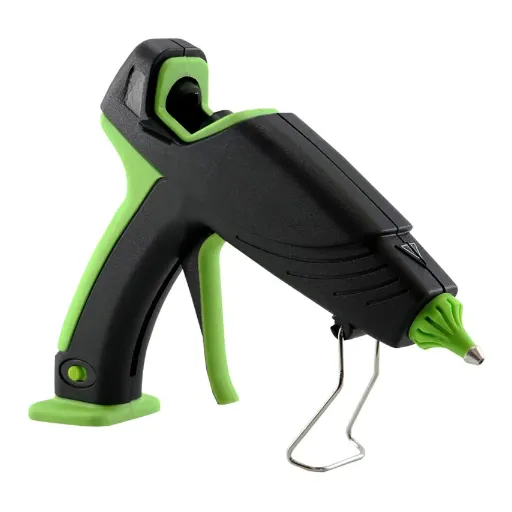
Can you use hot glue on Styrofoam?
✅ Yes, but with precautions!
Hot glue can be used on Styrofoam, but caution has to be exercised not to cause damage. Hot glue is preferred in numerous craft applications and some construction work because it can easily glue Styrofoam to other surfaces. However, the glue gun heat can sometimes melt or deform Styrofoam, especially if the glue is applied directly in very large amounts or at very high temperature.
Safety Guidelines:
- Use a low-temperature glue gun – Such guns heat the glue to just enough to melt and run without posing any risk to the Styrofoam
- Apply glue as dots or thin lines – Instead of thick globs to keep heat from directly attacking the Styrofoam
- Test on a hidden area first – Use the glue on a small portion of the Styrofoam before starting your main project
- Consider specialized adhesives – For greatest accuracy and safety, use adhesives made especially for Styrofoam
How to Glue Foam with Hot Glue
🔥 Step-by-Step Process
Use Low-Temperature Glue Gun
High temperatures will melt or warp the Styrofoam surface. Low-temperature glue guns apply the glue gently, less compelling for damage to the material.
Clean and Prepare Surface
Clean and dry the surface of Styrofoam to remove dust or debris. Consider light sanding to give better grip to the glue.
Apply Glue Carefully
Apply the glue liberally but not to the point of saturation. Press surfaces firmly and hold together for several seconds.
Let It Set
Place the glued Styrofoam in a resting position until the glue sets completely before moving or applying weight.
Potential Risks and Precautions
⚠️ Adhesive Damage Risk
Some glues (especially solvent-based types) can cause Styrofoam to dissolve. Always ensure adhesive is meant for Styrofoam use.
📏 Application Amount
Too much glue weakens the bond and prevents the proper structural load-bearing. Use only recommended amounts and apply evenly.
🌬️ Safety Precautions
Work in well-ventilated areas to avoid inhaling fumes. Use cooler environments to prevent Styrofoam melting from high temperatures.
Glue Options for Styrofoam Projects
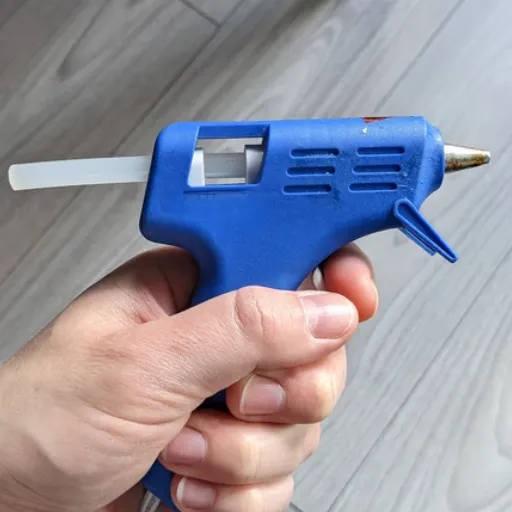
Comparing Hot Glue to Other Adhesives
| Adhesive Type | Advantages | Disadvantages | Best For |
|---|---|---|---|
| Hot Glue | Fast drying, easy application, strong bond | Risk of melting Styrofoam with high temperatures | Quick projects, lightweight pieces |
| White Glue (PVA) | Non-toxic, safe, dries clear, child-friendly | Slower drying time, less strength | Craft projects with children |
| Foam-Specific Adhesives | Designed for foam, strong hold, no material damage | Longer drying time, more expensive | Professional projects, long-term integrity |
| Epoxy | Excellent strength and durability | Harder to use, requires exact application | Heavy-duty bonding, industrial applications |
| Spray Adhesives | Even spread, good for large surfaces | Less precise application | Large surface bonding, uniform coverage |
When to Use Glue Sticks Versus Other Adhesives
📌 Glue Sticks – Best For:
- Light adhesion needs
- Arts and crafts projects
- School projects
- Paper or cardboard attachment
- Child-safe applications
- Quick, temporary projects
🔧 Other Adhesives – Best For:
- Stronger bonding requirements
- Professional/industrial settings
- Permanent bonds
- Complex projects
- Multiple material types
- Long-term durability needs
Best Practices for Gluing Styrofoam
🎯 Key Success Factors:
✅ Adhesive Selection
Choose adhesives that clearly state they are Styrofoam-safe or foam-compatible. Water-based or solvent-free types bond without harming the material.
🧹 Surface Preparation
Ensure surfaces are clean and dry. Lightly sand with fine-grit sandpaper to create more texture for better adhesive grip.
🌡️ Environmental Considerations
Ensure proper ventilation and avoid humidity that might lessen bonding. For heavy loads, clamp or weight pieces until adhesive sets fully.
Creative Projects Using Hot Glue and Styrofoam
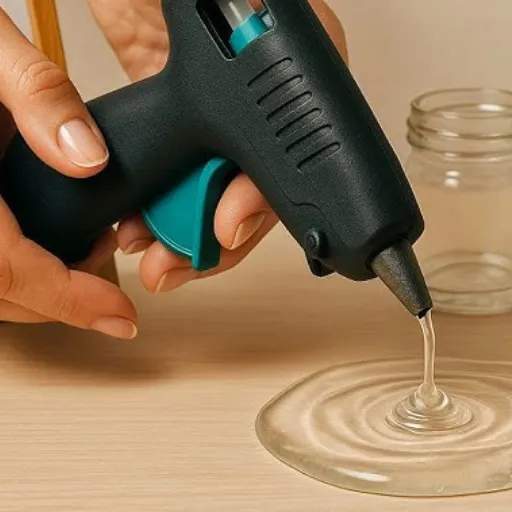
DIY Craft Ideas
🏠 Miniature Houses
Process: Sketch design, cut Styrofoam into shapes for walls and roof, use hot glue to assemble firmly, add paint and decorations for charm.
Tip: Start with simple rectangular designs before attempting complex architecture.
🎨 Custom Wall Art
Process: Cut Styrofoam into stylistic patterns, letters, or designs. Layer and group pieces, adhere with hot glue, paint with vibrant colors or metallic textures.
Tip: Create depth by varying foam thickness and layering techniques.
🎃 Holiday Decorations
Process: Create Christmas ornaments, Easter centerpieces, or Halloween props. Cut and shape festive designs, glue elements together, decorate with glitter, fabric, or paint.
Tip: Use seasonal color schemes and add lighting for dramatic effects.
🔥 Safety Reminder
Always observe safety measures when working with hot glue to prevent burns and achieve good results. Keep first aid supplies nearby and work in well-lit areas.
Model-making with Styrofoam
From students to professionals and hobbyists alike, model-making with Styrofoam is a very versatile and accessible craft. The lightness of the foam makes it easy to work with and is suitable for almost anything-from architectural mockups to some DIY work on the side! The smooth surface also accepts paint and finishing well to present detailed and polished-looking work.
🛠️ Essential Preparation Steps:
- Cutting: Use a sharp craft knife or hot wire tool for clean cuts
- Shaping: Sandpaper can smooth rough edges and create texture
- Assembly: Use appropriate adhesives like hot glue or Styrofoam-safe glue
- Finishing: Prime before painting for best appearance
- Safety: Work in ventilated areas when cutting or painting
♻️ Environmental Consideration
Styrofoam is also a more environmentally friendly option if one goes for leftover packaging or recycled material. This encourages sustainable crafting while controlling waste. Whether constructing complex models or simple prototypes, Styrofoam is cost-efficient and reflects the artist’s specifications!
Tips for Combining Styrofoam with Cardboard
Preparation is Key
Ensure both materials are clean and free from dust or debris. Pre-cut to right size and shape for precision and time-saving.
Choose the Right Adhesive
Hot glue gun works well for fast, strong joints. Use low-temperature glue to avoid melting Styrofoam. Apply in small dots or thin lines.
Add Protection for Strength
Use additional support like cardboard backing or tape over edges. Allow adequate drying time before handling to ensure strongest bond.
Frequently Asked Questions (FAQ)
❓ Can I use a hot glue gun on styrofoam?
Yes, hot glue guns can be used on styrofoam, but you have to keep in mind to use low temperature glue that won’t melt the foam. High temperature glue melts the styrofoam; hence, one should purchase glue meant for very soft materials.
❓ What type of glue works best with styrofoam?
Hot melt glues tend to be the ones recommended to glue styrofoams. Further options are tacky glue or PVA glue, both of which form a strong bond without risking melting of the foam.
❓ Is it safe to glue with a hot glue gun on XPS foam?
Using hot glue guns on XPS foams is fine if low temp glue is used. Using high temperatures can melt XPS foam, basically just the way it does with conventional styrofoam.
❓ How do I glue styrofoam to cardboard?
To glue styrofoam to cardboard, use hot glue for styrofoam. Apply lines of glue to the cardboard and press the styrofoam against the cardboard with some pressure. It is imperative to make sure you are using low temp glue for this as well.
❓ Can I glue styrofoam with Gorilla Glue?
Gorilla Glue, being a very strong glue, probably isn’t the best solution for styrofoam due to its expanding quality that would likely damage it. It is best to stick with hot glue or glues explicitly formed for styrofoam.
❓ Would hot glue melt the foamies?
Definitely, using a high-tempered glue gun can melt the foamies. It is recommended to use a low temp glue that does not damage the foam materials for safe and effective bonding.
❓ How long does it take for the hot glue to set on styrofoam?
The various put-ons by hot glue on styrofoam usually need a few minutes to hold, but for heavy-duty bonding, you ought to let the glue cure totally before applying pressure.
❓ Should I use solvent with hot glue on styrofoam?
It is not advisable to use a solvent with hot glue on any styrofoam, as it may dissolve the polystyrene. Stay off any solvent and use the glue as it is for safe and effective adhesion.
❓ Is there an easy way for me to remove hot glue from styrofoam?
Generally, it’s difficult to remove hot glue from Styrofoam. You could try gently scraping it off or use some heat to soften the glue, but carefully or you will melt the foam as well.
❓ Can school glue be used on styrofoam?
School glue can be used on styrofoam, but it will probably not provide the same strength of bond as hot glue or specialized adhesives for foam. Hot melt glue would work better for arts and crafts.
📚 References
- How to Glue Styrofoam for Your Next Project – WikiHow – Explains that hot glue can be used with a low-heat glue gun to avoid melting Styrofoam.
- How to Glue Styrofoam – CraftsUPrint – Advises against using hot glue guns on Styrofoam due to the risk of melting caused by high heat.
- What is a substitute for a hot glue gun? – Quora – Suggests alternatives like water-based contact cement for bonding Styrofoam.
- What are some ways to glue Styrofoam together? – Quora – Recommends using hot glue on a low-heat setting to prevent melting.
- How to glue Styrofoam: Tips for Styrofoam and polystyrene – Loctite – Highlights spray adhesives like Loctite Spray Adhesive Multi-Purpose as an effective option for Styrofoam.
















